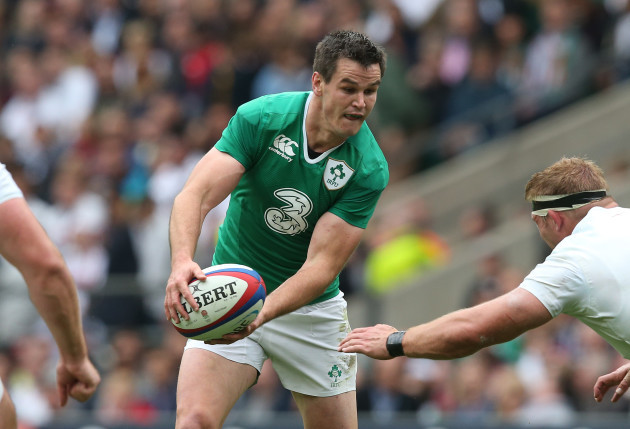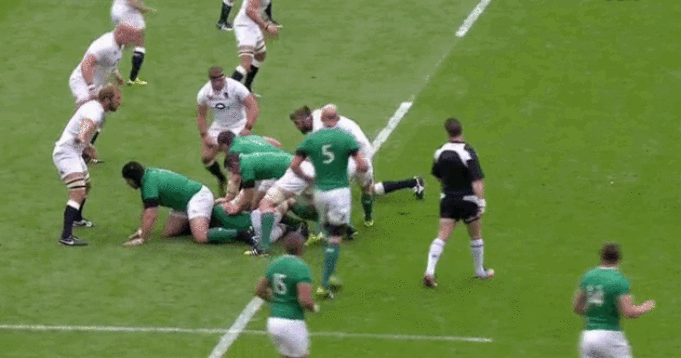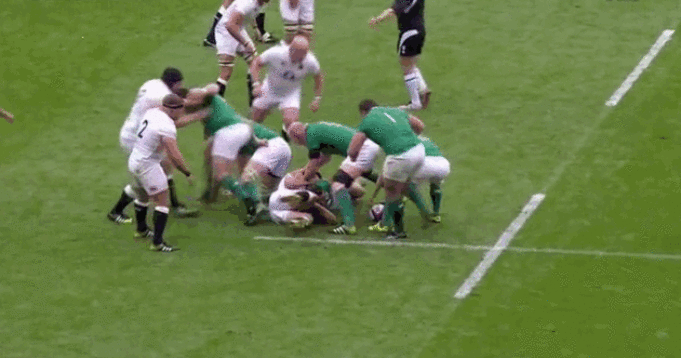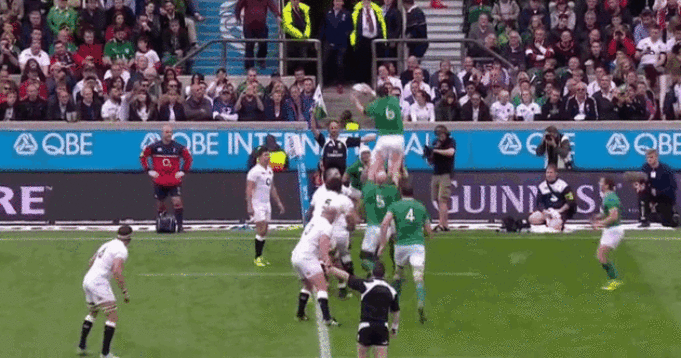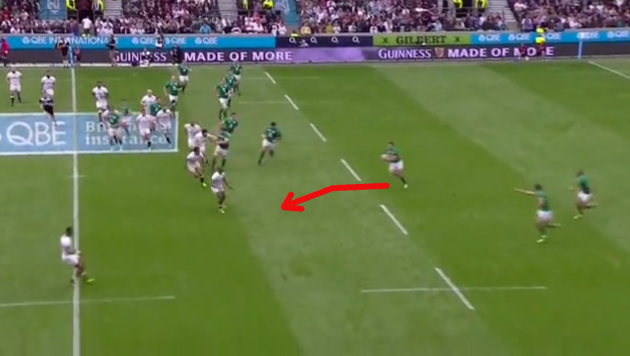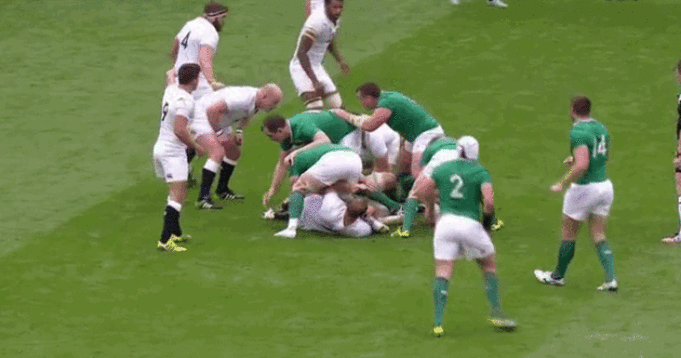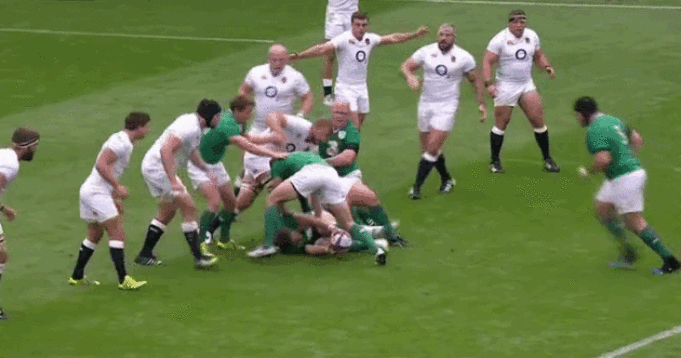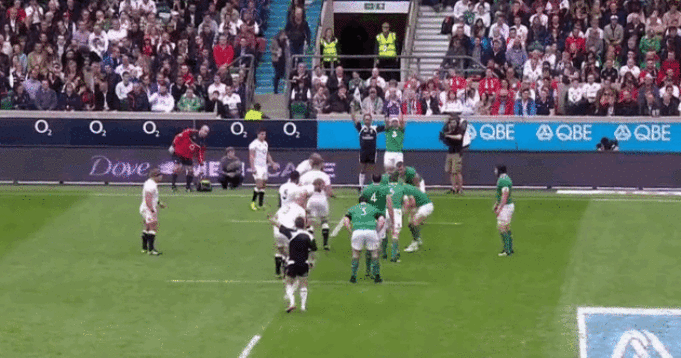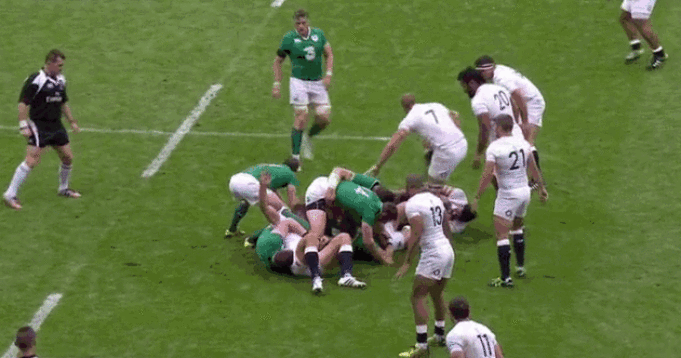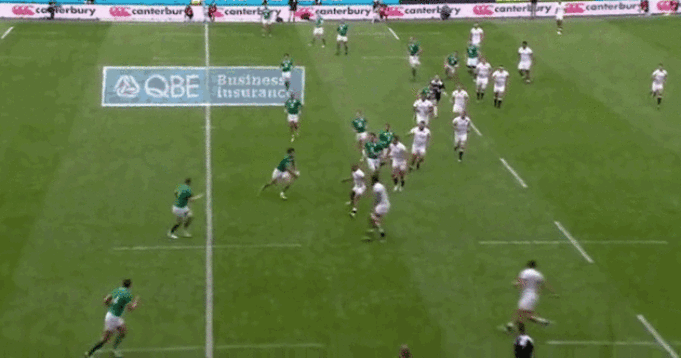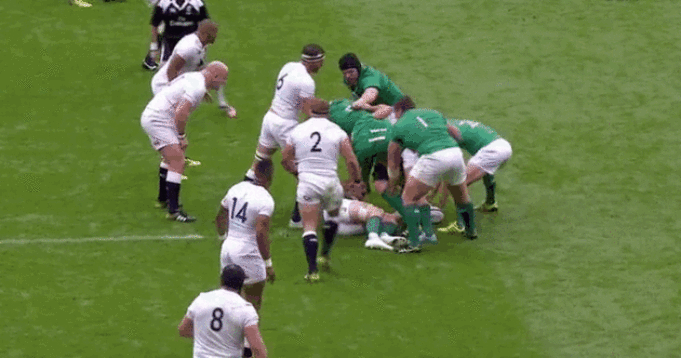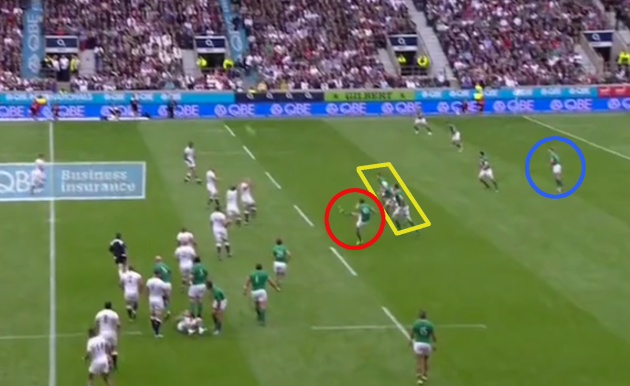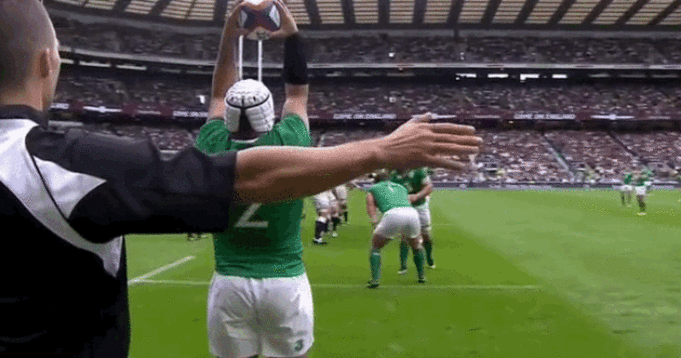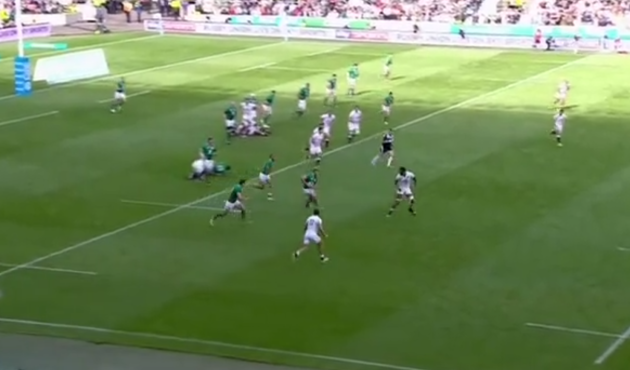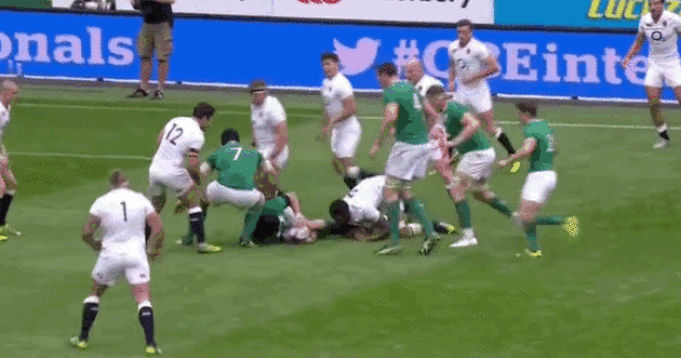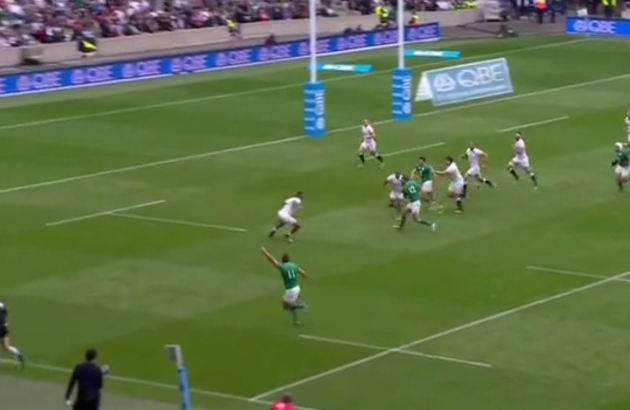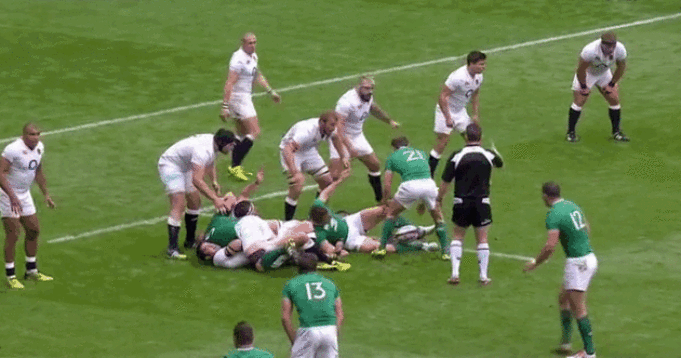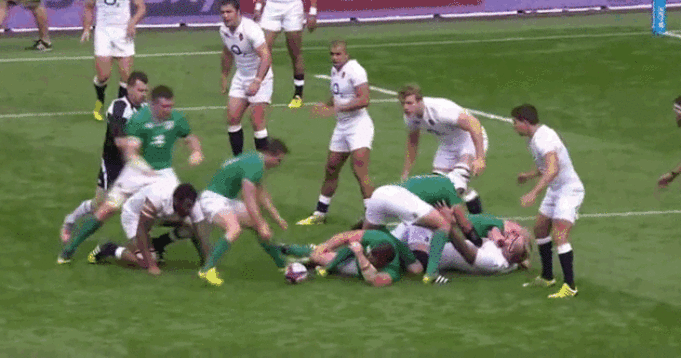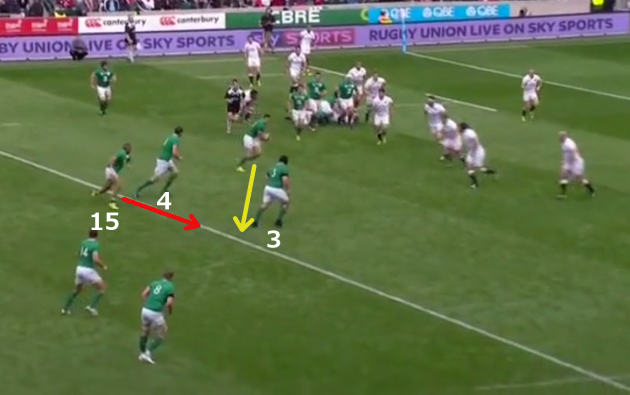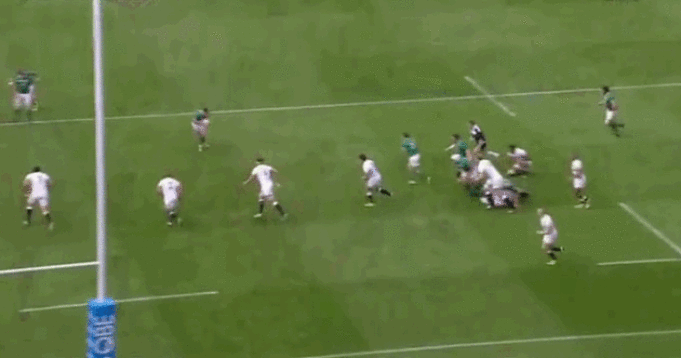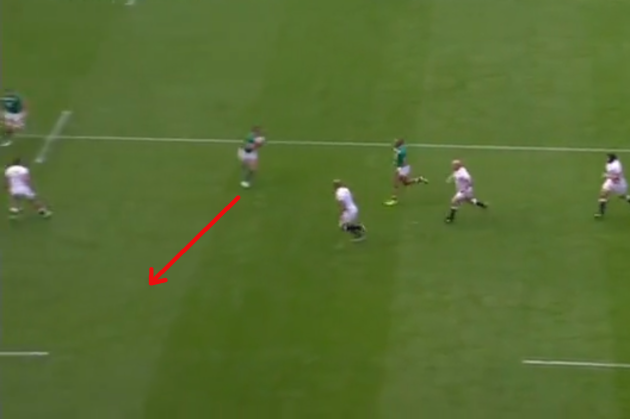ANYONE EXPECTING IRELAND to unveil an all-offloading, line-busting attack for the World Cup can probably recalibrate their assumptions.
There will certainly be add ons, but the formula Joe Schmidt’s side believe can bring them a first-ever semi-final is likely to be largely based on the habits they have developed since 2013.
Sorting out the foundation that is their defence is the priority, while a kicking game that stuttered in Twickenham last weekend will remain vital.
Ireland’s focus under Schmidt has usually been on earning field position by pressuring the opposition into conceding penalties or failing under their kicking game, then turning the gained territory into points through their excellent maul or by bludgeoning over from close range.
While they have held back their very best pre-rehearsed power plays and set-piece moves, Ireland have given hints of a development in their phase play attack over the last month, with signs of the same coming again last weekend.
After defeat to Wales in this year’s Six Nations, the limits of Ireland’s narrow focus in the opposition 22 against the very best defences came to the fore and it has been encouraging to see clues that they have moved to add to their attacking portfolio in this area.
The main issue in Twickenham was that Ireland coughed up the ball time after time after time in an uncharacteristic manner, as much of an indicator that their mindset wasn’t correctly tuned for the meeting with England as the passive defensive display was.
Too much focus on tactics and technique? The pressure of the looming tournament? A relaxation of motivation levels after the final 31-man squad was selected? Whatever it was, the lesson will have been learned and leaders like Paul O’Connell will look to ensure it never happens again.
Keep the ball
No matter how good or bad a team’s attacking tactics are, an inability to catch and pass takes those plans entirely out of the equation.
While this was just the second game of the season for a handful of Ireland’s players, the number of knock-ons and losses of possession in contact against England was at a level Schmidt and his coaching staff will have deemed absolutely unacceptable.
Ireland enjoyed around 50% of the possession in the first half and showed some promise with ball in hand at times, but their inability to hold onto it cost them dearly.
Above, we see the usually reliable Jamie Heaslip lose possession as he looks up at the onrushing England defence before completing his catch. The handling error is compounded by the Ireland number eight being caught offside in his eagerness to redeem himself.
England kick the penalty into Ireland’s half and very nearly score through Jonny May, only for the try to be disallowed for a forward pass from Tom Young. All stemming from a simple Ireland error.
There are so many examples we could look at in relation to Ireland’s poor handling, with Tommy Bowe spilling the ball in the clip above as he attempts to offload after what looks like a forward pass from Jared Payne.
The defensive read and tackle from May coming from backfield is absolutely world class, but it’s just one of the many times Ireland limited their ability to build the kind of pressure that they focus so intently on.
Lateral
Ireland have tended to concentrate on using one-out runners close to the ruck when they’ve attacked inside the opposition half under Schmidt, but then so do many teams around the world.
Schmidt’s side do, however, look to width at times and did so on a number of occasions against England, but there was an issue with how lateral they were, as outside backs often missed the opportunity to straighten the line or at least fix defenders.
Ireland play to the far touchline in the clip above, and they do actually make a gain through Dave Kearney, but there could have been a greater threat posed had they occupied England’s defenders a little more and prevented a comfortable drift.
Can Sean O’Brien do more to disrupt Ben Morgan on his decoy line? Can Robbie Henshaw straighten back up slightly to threaten as a possible carrier before bouncing back out to deliver the pass to Simon Zebo?
Brad Barritt and Jonathan Joseph are relatively at ease in drifting across the pitch in England’s midfield here, with Payne never really looking like a realistic target outside Henshaw.
Even the most subtle straightening check from Henshaw when in possession – which Payne seems to be indicating for him to do – could have helped the Ulsterman look like a viable target, even if Henshaw had then bounced back out to send the long pass to Zebo.
For Ireland to have made a linebreak in this situation would have taken a serious malfunction in the English defence of course, but the only way to cause that is with attacking perfection.
As it is, Schmidt’s side manage to make further ground on the proceeding phases before another handling error means they turn the ball over.
Mike Ross just doesn’t read Johnny Sexton’s intentions here, though the reaction from the out-half is possibly one his teammates won’t have appreciated.
Just over a minute later, Ireland are back into good field position but give up another turnover, this time with Morgan making a clean steal at the breakdown.
Ireland’s urgency in getting to the ruck just wasn’t consistent enough against the English, the above being a prime example as Devin Toner and Peter O’Mahony arrive late. Again, we must underline the brilliant defensive effort from England, with Morgan clamping over the ball at lightening speed.
That said, Ireland’s ruck accuracy and speed is their lifeblood, particularly given that this team is not packed with destructive ball carriers.
Fast forward 30 seconds after the above turnover and once again Ireland make a simple error in attack for another loss of possession.
This time it’s O’Brien’s inside pass that gets picked off and it caps off a remarkably frustrating three minutes for Ireland in which they turn the ball over three times in attack.
Moving back to the point about lateral attack, there were several other examples through the 80 minutes and its something Schmidt is likely to have raised with his players.
Ireland use a lovely linking pass – something we will return to – to shift the ball in this example, but Darren Cave moves the ball on again without ever looking to square back up to the defence or engage any defenders.
The passes from the Ulster centre and O’Brien are sloppy and even though an excellent contribution from Dave Kearney wide on the left allows Ireland to make good gains, they have to ask if they can do better here in moving the ball to that outside edge.
If Cave can straighten back up on the ball or just force Tom Wood to make a decision, the English front line drift is far less likely to be able to get across to cover Kearney. Too often on Saturday, England found it easy to shadow Ireland across to the touchline.
Despite Kearney’s lovely touch with the boot putting Ireland into another promising position here, they coughed up the ball once again several phases later as Payne was stripped in the tackle by opposite number Joseph.
Linking
We looked at some of the nice attacking shape Ireland added during their victory over Scotland, and after those linking passes from forwards were unused against Wales in Dublin there was a renewed focus on the tactic last weekend in London.
The clip above in which Cave might have interested a defender before passing shows the shape we’re talking about, as Henry plays the linking role between first receiver Zebo and Cave, who hovers out the back door.
This shape is a relatively new addition to Ireland’s play, and something they are still getting used to as they return to full fitness and sharpen their skills. It certainly helps create opportunities in skirting aggressive defences, but Schmidt’s men must constantly stay awake to chances to fully utilise it.
Above, we see an example of an occasion where Ireland are loosely set up to attack with this rugby league-style shape, but instead opt to kick deep to an area of the field England have well covered.
This was one example of where Ireland’s fresh attacking shape could have been hugely effective.
We can see above that England’s front line defence is not stacked with bodies and there is space on the outside edge if Ireland can move the ball there.
The elements for this Bath-style shape are set up and with just a little adjustment Ireland can cut the English defence here. Sexton (red) is the first receiver and he has a bank of three forwards outside him in Toner, Rory Best and O’Mahony (yellow).
If that pod of forwards can just get a little wider for their starting position, Sexton would have the opportunity to fire a pass to Best in the middle of the trio. If Henshaw (blue) can then get into a position for Best to pull the pass to him out the back door, Ireland are up and running with England’s defence almost certain to be in trouble.
It’s very easy to point these things out when re-watching the game and without the crushing fatigue of 34 minutes of Test rugby crushing one’s lungs, but it points to one of the issues in this Ireland attack – the need for constant awareness of opportunities.
Clinical
England could have had at least three more tries in this game had they shown a more clinical edge, but Ireland too will reflect on missed chances at Twickenham.
Schmidt’s men were effective in converting a close-range lineout in the second half through Paul O’Connell, but their first-half failure in that zone was extremely frustrating.
With 32 minutes on the clock and Ireland somehow only trailing 12-3 after being blown away by England in the opening quarter, they found themselves with this opportunity to utterly change the momentum of the game.
England and the excellent Geoff Parling once again deserve credit for their defensive competence in getting off the deck accurately when so many other teams would have stayed down to defend the maul, but it’s a blown opportunity from Ireland nonetheless.
With the game back to 15-13, Ireland wasted an excellent chance to counter back at England after some foraging work in the ruck from O’Connell handed them possession deep in their half.
With England forced to transition suddenly, it was a wonderful invitation for Ireland to go the length of the field or at least make huge territorial gains.
It’s a three-on-two situation for Henshaw, the type of unstructured scenario rugby players at all levels around the world will know well from the training ground.
The Ireland centre must look to dominate the opportunity, but instead seems initially indecisive, almost waiting for Courtney Lawes or Jonny May to make his mind up for him by diving in and leaving one of Zebo or Sexton free in space.
Schmidt cut a frustrated figure in the stands as the overhead pass attempt from Henshaw went forward, a disappointing conclusion to a promising situation and emblematic of the Irish performance.
Indeed, Ireland haven’t always looked comfortable counter-attacking on turnovers in the last two years but given the strength of several of their forwards at the breakdown, it is an area in which they could get great reward.
It was an obvious example of Ireland failing to be clinical in this game, but they had other, clearer scoring chances at Twickenham.
The clip provides a superb illustration of how effective the Bath-esque shape can be for Ireland, as they organise themselves perfectly after hammering at the English defence over a number of phases, drawing in defenders and building momentum before releasing the ball wide.
It’s superb execution from O’Mahony in the middle of Ireland’s pod of forwards and Payne holds beautiful depth out the back, allowing himself time to fully skirt around the onrushing England defence led by Chris Robshaw in the middle of the pitch.
England’s defence is in real trouble as Payne – crucially posing a carrying threat himself – gets to the outside of Morgan and interests Joseph. That in turn drags right wing Anthony Watson in towards the ball and suddenly the space is there for Ireland.
A perfect pass from Robbie Henshaw in this instance almost certainly means a try for Kearney, but it’s easier said than done. The pass from Payne to Henshaw appears to be up towards the Connacht man’s right shoulder and that means he just has to juggle the pill before he can move it on to Kearney.
The result is that Henshaw’s transfer out to Kearney is delayed and then behind the wing when it does arrive. The window of opportunity shuts and Ireland’s centres will have been hugely annoyed with their handling on this occasion.
Continuing the theme of the contest, O’Brien is stripped by Ben Youngs two phases later and with Ireland still in an excellent field position.
Ireland’s strong start to the second half brought them three points from a Sexton penalty and then the O’Connell try, but there was another opportunity left untaken in the midst of the purple patch.
Again, it was a failure to convert space on the outside edge into a try and it’s another example Schmidt and his players are likely to have been left frustrated by.
We saw earlier how Zebo can step into first receiver and act as something of a playmaker, and it’s certainly a theme from Ireland’s games in the last 12 months whenever the Munster man is on the pitch, whether at fullback or on the wing.
In the clip above, we get another example of Ireland using Zebo (15 below) as a passing fulcrum, this time as he accepts the ball from Sexton through a nicely-formed tunnel of Toner marked 4) and Ross (1).
With Zebo getting all the way to the outside shoulder of England prop Dan Cole, there’s suddenly a chance for Ireland. Henshaw’s utter frustration at the ball not arriving to him is clear, as he understands exactly how big an opportunity they have blown.
Is there any need for the loop play between Zebo and Bowe here?
The Ireland fullback doesn’t appear to expect the return pass from the Ulsterman, but whether or not it’s actually part of the play they have called, Ireland have to keep the heads up and scanning.
Could Bowe have backed himself to get all the way outside the scrambling Chris Robshaw and burst for the line?
Even if he didn’t beat the England captain, that intent would have likely drawn May into biting in and allowed Bowe to either pass or offload to Heaslip outside him in space.
Even when the pass is returned to Zebo, the chance is still on for Ireland. As we see below, it’s a clear three-on-two.
Henshaw wants the skip pass or perhaps a delicate grubber through from Zebo, but whatever the means, Ireland simply have to be clinical in finishing here.
May is in a position to pick off an attempted pass from Zebo and once again we must highlight the England wing’s sensational defensive work. His agility and awareness in initially backing off and then closing Ireland’s options is sublime.
There’s just a lack of conviction from Ireland however, both in Bowe’s failure to grab the situation by the scruff of the neck and the subsequent indecisiveness on the outside edge.
What is positive in both of these examples of Ireland missing chances on the outside edge is how they are creating them.
Defeat to Wales in the Six Nations was a big moment for this team and we discussed after that game how the predictability of Ireland’s attack in the opposition 22 was a major issue moving forward.
One-out runners off the scrum-half smashing their way to the line doesn’t always works on its own, but combined with some of the clever shape we see in these two examples, there are a whole lot more questions asked of defences.
Ireland are certainly moving in a positive direction in that sense, but they simply must be clinical when they do get into positions to score tries.
The expectation is that an improvement in their mental focus and clarity will see a notable step up in their handling skills and ability to draw defenders before passing. When that happens, Ireland’s attack can cause much more damage than it has in the last fortnight.
All the while, close-range mauls and maul variations from O’Connell’s pack will remain pivotal to Ireland’s World Cup ambitions.
